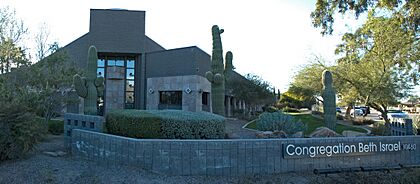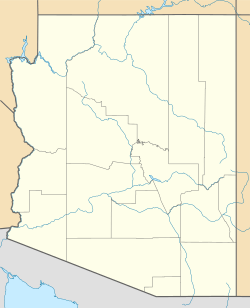Congregation Beth Israel (Scottsdale, Arizona) facts for kids
Quick facts for kids Congregation Beth Israel |
|
|---|---|
|
Hebrew: בית ישראל
|
|

Beth Israel synagogue, in 2009
|
|
| Religion | |
| Affiliation | Reform Judaism |
| Ecclesiastical or organisational status | Synagogue |
| Leadership |
|
| Status | Active |
| Location | |
| Location | 10460 North 56th Street, Scottsdale, Arizona |
| Country | United States |
| Administration | Union for Reform Judaism |
| Architecture | |
| Architect(s) | Lescher, Kibbey, and Mahoney (1922) |
| Architectural type | Synagogue architecture |
| Architectural style | Mission Revival (1922) |
| Date established | 1920 (as a congregation) |
| Completed |
|
| Capacity |
|
Congregation Beth Israel (Hebrew: בית ישראל) is a Jewish congregation and synagogue located in Scottsdale, Arizona. It follows Reform Judaism, which is a modern way of practicing Judaism. The congregation started in 1920. In 1935, it joined the Union for Reform Judaism, a larger group of Reform synagogues.
Two important leaders were rabbis Abraham Lincoln Krohn and Albert Plotkin. Rabbi Krohn served from 1938 to 1953, and during his time, the congregation grew a lot. Rabbi Plotkin then led the congregation for almost 40 years.
The first building for Beth Israel was in Downtown Phoenix. It was built in 1921–1922 and is now a historic landmark. After the congregation moved, the building was used by churches. In 2002, the Jewish community bought it back. It was restored and opened in 2008 as the Cutler-Plotkin Jewish Heritage Center, which is now a museum.
As of 2025, Beth Israel is the oldest synagogue in the Phoenix metropolitan area. The main rabbi is Stephen Kahn, and Sara Mason-Barkin is the associate rabbi. Seth Ettinger is the cantor, who leads the music and prayers.
Contents
Early Years and First Building
Starting the Congregation
Jewish people living in Phoenix began holding special services for High Holidays as early as 1906. A lawyer named Barnett E. Marks helped create a formal group. They held services in a room above a saloon and started a Sunday School for Jewish education. By 1918, the group was called "Emanuel."
In 1920, the congregation officially became "Congregation Beth Israel." Their first rabbi was David L. Liknaitz, and Charles Steinberg was the first president.
Building the First Synagogue
The congregation used different temporary places for services. In 1921, local Jewish groups bought a church building. They changed it into Phoenix's first synagogue. Congregation Beth Israel later took over this building.
That same year, the congregation raised money to build a new synagogue. They hired architects to design a building in Downtown Phoenix. The building was finished in 1922. It had a simple style called Mission Revival.
At that time, only about 120 Jewish people lived in the Phoenix area. The synagogue became a central place for the Jewish community. It hosted events like Passover Seders, which were important because Jewish people sometimes faced discrimination in other public places.
Challenges and Changes
During the 1920s, it was hard for the synagogue to keep rabbis for long. Most stayed only a few years. In 1930, some members left to form a new group called Beth El Congregation. They wanted a more traditional approach to Judaism.
Samuel Dodkin Hurwitz became Beth Israel's rabbi in 1930. He was born in Belarus and came to the United States as a child. He later became a rabbi and served on the board of the Phoenix Public Library.
In 1935, Philip W. Jaffa became the rabbi. He introduced the Reform Judaism's Union Prayer Book and added choir music to services. A fire destroyed much of the synagogue building that year. The congregation rebuilt and added a religious school building.
Growth Under Rabbi Krohn
A New Leader
Abraham Lincoln Krohn became Beth Israel's rabbi in 1938. He took over from Rabbi Jaffa, who was not well. At that time, the congregation had fewer than 100 families. Rabbi Krohn was named after Abraham Lincoln and was known for his kindness and intelligence.
Rabbi Krohn was very active in the community. He served on many boards, including the Urban League and the American Red Cross. He also helped start the Jewish Family Service.
Under his leadership, the synagogue grew a lot. It started being called "Temple Beth Israel."
World War II and Expansion
During World War II, Beth Israel provided religious services for soldiers at Luke Air Force Base. They also hosted dances for military personnel. In 1942, the synagogue started its Judaica library, which began with 60 books.
By the late 1940s, the congregation had grown to about 300 families. The original building was too small. In 1949, the congregation moved to a new, larger location at Eleventh and Flower. They also officially joined the Union of American Hebrew Congregations, which is now the Union for Reform Judaism.
The original building was sold to a Baptist church. In 2002, the Jewish community bought it back. This historic building is now listed on the city's historic property register and the National Register of Historic Places.
When Rabbi Krohn retired in 1953 due to health issues, the congregation had grown to 538 families. He also worked to improve understanding between different religions.
Later Leaders and New Locations
Rabbi Albert Plotkin's Long Service
In 1955, Albert Plotkin became the rabbi of Beth Israel. He was born in 1920 and grew up in Indiana. Rabbi Plotkin was very involved in both the Jewish and wider Phoenix communities. He strongly supported Israel and civil rights. He also helped start the Jewish Studies program at Arizona State University.
In 1972, he received an award for promoting brotherhood among people.
The Sylvia Plotkin Judaica Museum
In 1967, Beth Israel added a "cultural and educational wing" to its Flower Street building. Rabbi Plotkin's wife, Sylvia Plotkin, started a Jewish museum there. The museum had different galleries, including one with items from a synagogue in Tunisia.
Sylvia Plotkin directed the museum until she passed away in 1996. The museum was renamed the "Sylvia Plotkin Judaica Museum" in her honor. It became one of the largest and most respected synagogue museums in the United States.
Rabbi Albert Plotkin served the congregation for almost 40 years, retiring in 1992. He became rabbi emeritus, which means he held an honorary title after retirement.
Moving to Scottsdale
Kenneth Segel became the rabbi in 1992. In 1997, the congregation moved to its current location at 10460 North 56th Street in Scottsdale. The new building is large and includes a main sanctuary that can seat 500 people. The Torah ark, where the holy Torah scrolls are kept, is beautifully decorated with colored glass.
Rabbi Segel served until 2002.
Recent Events and Community Focus
Rabbi Stephen Kahn and Continued Growth
Stephen Kahn became Beth Israel's rabbi in July 2003. By then, the congregation had about 1,000 families, making it the largest Jewish congregation in Arizona. The synagogue's library, which is open to everyone, grew to over 20,000 books. It is one of the biggest Jewish libraries in the Southwestern United States.
In 2005, the congregation bought more land near its building to allow for future growth. At that time, the synagogue had over 900 member families.
That same year, the congregation changed its name back to "Congregation Beth Israel." Rabbi Kahn felt that "congregation" better represented the idea of people and community, while "temple" often refers to a building.
The Cutler-Plotkin Jewish Heritage Center
In 2007, the Arizona Jewish Historical Society began a project to restore the original synagogue building in Downtown Phoenix. The goal was to create the Cutler-Plotkin Jewish Heritage Center. This center would include a museum and other public spaces to show the history of the Jewish community in Arizona.
The first part of the restoration was finished by August 2008. The center helps people learn about Jewish history and its connection to Arizona's past.
New Traditions and Community Outreach
In 2007, Beth Israel opened the first mikvah (a ritual bath) in the Phoenix metropolitan area. This was a special event because it was approved by rabbis from different Jewish traditions: Reform, Conservative, and Orthodox.
The congregation also hired Jaime Shpall as cantor that year. As of 2025, Beth Israel is still the oldest congregation in the Phoenix area. The congregation also owns and runs Camp Daisy and Harry Stein, a Jewish overnight camp near Prescott, Arizona. It is the only Jewish camp in the area.
Cutler-Plotkin Jewish Heritage Center
The Cutler-Plotkin Jewish Heritage Center is located in the historic former synagogue building at 122 East Culver Street, Phoenix. It was named after Rabbi Emeritus Albert Plotkin and Lawrence Cutler, a major supporter of the synagogue. The building was designed in 1920 in the style of a Spanish mission.
The congregation sold the building in 1949. It was later used by different churches. In 2002, the Arizona Jewish Historical Society bought the property. After it was restored, the former synagogue was added to the National Register of Historic Places in 2011. It is also recognized as one of the Phoenix Points of Pride.
See also
 In Spanish: Congregación Beth Israel para niños
In Spanish: Congregación Beth Israel para niños
- List of historic properties in Phoenix
- National Register of Historic Places listings in Phoenix, Arizona
- Phoenix Historic Property Register


